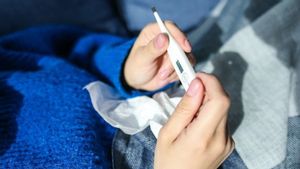JAKARTA – Anthurium is an ornamental plant that needs special care, especially when placed indoors. One of the varieties of anthurium, namely anthurium crystallinum is also known as elephant ear. Anthurium belongs to the Araceae family which is still a relative with aglaonema, philodendron, caladium, and alocasia.
Compared to its relatives, anthurium has a genus of about 1000 species at most. Of the many genera, need to be cared for properly. Well, mistakes in caring for it can cause disrupted growth, such as root rot, not growing and flowering, and the leaves turning brown. So, avoid making these 5 mistakes.
1. Improper wateringAnthurium needs a lot of water to support its growth. However, overwatering or excessive watering can trigger bad things. First, overwatering can make the growing media moldy and prone to becoming a breeding ground for bacteria.
Second, watering anthurium needs to be done properly. The trick, pay attention to the level of wetness of the planting medium. Too much water can trigger anthurium root rot. When watering, avoid spraying the leaves until they are wet as it contributes to late blight.

Fertilizers containing nitrogen are needed by plants, including anthurium. However, avoid applying too much nitrogen-containing fertilizer as it triggers leaf burn and inhibits flowering.
3. Incorrect temperature causes yellowing of leavesAnthurium plants are tropical plants that love the sun. But if it is too hot, it can make the leaves turn yellow. Just like when not exposed to the sun, or in a cold room, the leaves change color and fall off.
Generally, anthurium can thrive between temperatures of 21-32 degrees Celsius. At temperatures below that, make sure to put it in a warmer place.
4. Putting it in the wrong placeOn the one hand, anthurium plants love the sun. The more light it gets, the more flowers the anthurium will produce. However, as reported by Plantophiles, Wednesday, December 15, direct sunlight will affect the anthurium. The effects of direct exposure to the sun's heat can make anthurium plants dry and die.
5. Not routinely checking for pestsThe most common pests that plague anthurium plants are mealybugs and aphids. Mealybugs or mealybugs are Hemiptera insects that are white in color and have a white protective powder to hide. The mealybug generally hides in the branches of the trunk or under the leaves.
The mealybug absorbs plant nutrients and depletes the anthurium's juices if it bites. Eventually making the plant look not fresh, the leaves begin to turn yellow, and kill the plant. To eradicate anthurium plant pests, especially mealybugs, it is necessary to check regularly.
The way to eradicate it can be by spraying anti-pest before it comes to attack. Or by combing every part of the plant, pruning it, and removing it away from the plant area.
In addition to mealybugs, pests that often attack anthurium include aphids, thrips, spider mites, and bacterial diseases that stick to the edges of the leaves. Well, to anticipate being attacked by pests, do periodic checks and provide natural antifungals.
The English, Chinese, Japanese, Arabic, and French versions are automatically generated by the AI. So there may still be inaccuracies in translating, please always see Indonesian as our main language. (system supported by DigitalSiber.id)













